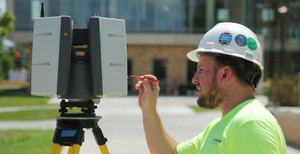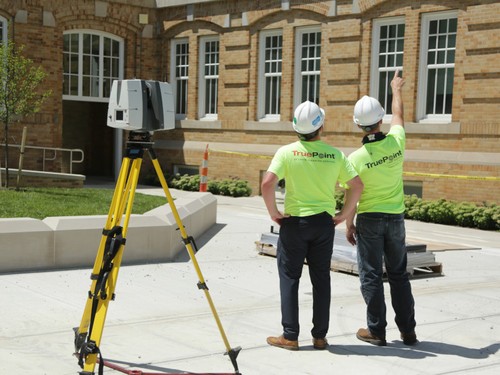
7 Tips Before 3D Laser Scanning
Preparing project information before laser scanning can bring huge benefits. At GPRS, we have turned our experience into advice to make your project successful. Here are 7 tips to read before you begin laser scanning.
1. Communicate the intended use of the laser scan data
The first step in using laser scanning is to communicate how the data will be utilized. Will it assist in design engineering? Verify existing conditions? Coordinate mechanical trades during the construction phase? Retrofit plant upgrades? Prefabricate building components? With this information, we can advise you on the best method to approach the project. One common mistake is not to involve end users of the data. End users can consist of your technical team, architects, engineers or other consultants that will be utilizing the data. All stakeholders should have an involvement at the beginning of the project to ensure that the deliverables meet their needs and ensure the project’s success.
2. Communicate the environment where laser scanning is being applied
Be sure to communicate details of the physical space needing scanning. Is it interior or exterior space? Occupied or unoccupied? Finished space or demolished wreckage? How many floors? Do you need the roof and the basement scanned? Are there any areas that are difficult to access, such as only being accessible by ladder? We need this information to prepare the best scanning plan while on site and ensure we have the appropriate equipment, tools and personnel.
3. Determine scope of work
What exact details of the project space do you want to capture? Provide a clear description of the project scope. This will ensure we collect all necessary project information while onsite the first time. It will be time consuming and expensive to go back and collect missing information. Adding or changing scope onsite can be problematic if appropriate pre-planning is not performed. The necessary tools and equipment may not be available if the scope changes, potentially causing delays or change orders.
4. Determine the required deliverable
Do you just want the point cloud (raw scan data)? Do you want 2D drawings or a 3D model? Are you going to use it in AutoCAD or Revit or some other software? There are various types of software platforms used throughout the design and construction industry. Be sure to state the specific software, version and file format that you will be using the deliverables in. Do you want a fully-developed intelligent 3D BIM model or would a generic model suffice? Do you need 2D floor plans, elevations or reflected ceiling plans? Also, be sure to let us know if you want the final deliverables shipped on a hard drive or shared online. Keep in mind that data sizes can be in the hundreds of gigabytes into the terabytes so many users prefer having a drive shipped to them in lieu of trying to download and store such large files on their local machine.
5. BIM LOD (Level of Detail)
Know what space you want modeled and how detailed you want the modeling to be for each feature. Do you need all piping detailed, or pipes above a certain diameter? And know what features you want modeled. Do you need just walls, ceiling and floor, or do you need doors, windows, furniture, light fixtures, or other features – and how much detail do you need on each item? Is a generic window good enough for the project needs or do you need the exact window details? By defining LOD specifications for each area scanned, we can clearly communicate with each other without confusion for faster execution. Keep in mind that the greater detail and more features needed, especially finite details, will take longer and cost more to create the final deliverables.
6. Communicate the timeline to deliver the finished product
What is the project timeline? Data from laser scanning will be of little use if it’s not available at the crucial deadline. 2D CAD and 3D modeling requires expertise, it takes some time to create this from the point cloud data. Be sure to communicate the date you will need the finished deliverable. There is a saying that there are 3 types of service -- Good, Cheap and Fast, but you can only pick 2.
- Good & Cheap -- Won’t be Fast
- Fast & Good -- Won’t be Cheap
- Cheap & Fast -- Won’t be Good
Try to provide reasonable needs and expectations to ensure your project meets your objectives. If you have a short timeline, is it possible to prioritize which features are modeled first and provide progress models along the way to allow the project to keep moving forward while the deliverables are completed to the needed specification.
7. Communicate site access
Communicate the best time to access the site for laser scanning. Are you looking to scan a site that is restricted (like a processing plant) or one that can only be scanned at night (like an airport terminal)? Is there any safety training or security clearance requirements? We will develop a site access plan to efficiently complete laser scanning. Make sure the site is ready, accessible and anyone that needs to know the Scan Team will be on-site is notified ahead of their arrival. The faster and more efficiently the Scan Technicians can get on and off site will reduce costs and avoid overages and change orders for extended trips or remobilizations.
GPRS has an experienced and dedicated laser scanning team. We understand laser scanning construction processes and technology. To maximize value and minimize cost, use the tips above to make sure we have a firm understanding of the project at hand.
If you’re considering laser scanning and need help answering these questions or determining if laser scanning is right for you, call us at 419-843-7226 or email Laser@gprsinc.com.

